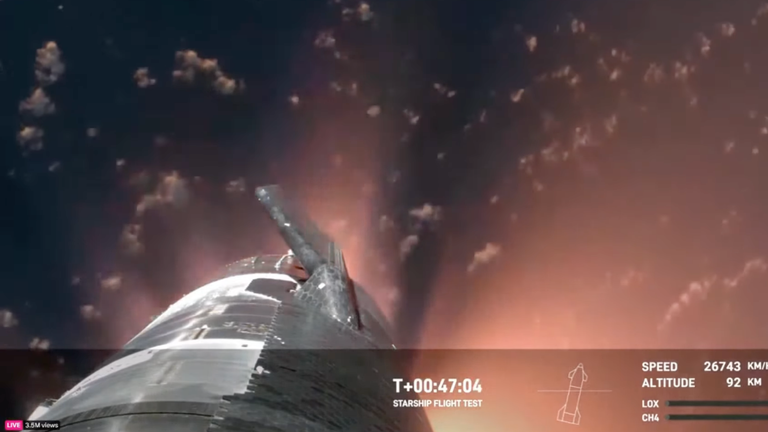SpaceX’s Starship completed nearly its entire test flight after blasting off in a successful launch.
The rocket cleared its launch pad in Texas, separated from its “Super Heavy Booster” and began coasting at an altitude of 145 miles.
But it was eventually destroyed as it re-entered the atmosphere, the company said.
However, it’s still the most successful test flight of the spacecraft yet.
Starship is the world’s biggest and most powerful rocket, at nearly 120 metres tall, and is intended to carry astronauts to the moon this decade.
It’s big enough that SpaceX says it “will be able to carry up to 100 people on long-duration, interplanetary flights”.
Reset
Ultimately, Elon Musk, SpaceX’s billionaire founder and CEO, wants Starship to fly to Mars.
Every test flight SpaceX conducts gets them closer.
This is Starship’s third test.
The first time the giant rocket was launched in April 2023, it exploded less than four minutes into a planned 90-minute flight.
The next launch in November lasted around eight minutes before exploding.
Musk said the rocket should fly hundreds of uncrewed missions before carrying its first humans.
Last year’s test flights were designed to show the spacecraft’s two stages could separate after launch.
Today’s flight was to attempt to open the payload door and reignite an engine in space.
Dr Daniel Brown, an astronomy expert at Nottingham Trent University, said: “It’s been reassuring to see how both booster and Starship survived the separation, which is what failed last time.”
“It looks as if we have lost Starship with it not having completed full descent, but SpaceX was never intending to recover the Starship.”
Before lift-off, SpaceX commentator Kate Tice reminded viewers: “Today is still just a test. Any data received will help us improve.”
“That’s the goal of flight tests,” added Siva Bharadvaj. “They teach us about the limits of our design and improve our understanding of the vehicle.”
NASA administrator Bill Nelson congratulated SpaceX on a successful launch.
He tweeted: “Starship has soared into the heavens.
“Together, we are making great strides through Artemis to return humanity to the Moon – then look onward to Mars.”
SpaceX says Starship will eventually carry cargo to Mars in order to “build cities” on the planet and NASA is giving it a central role in its Artemis programme, which aims to land astronauts on the moon for the first time in more than 50 years.









